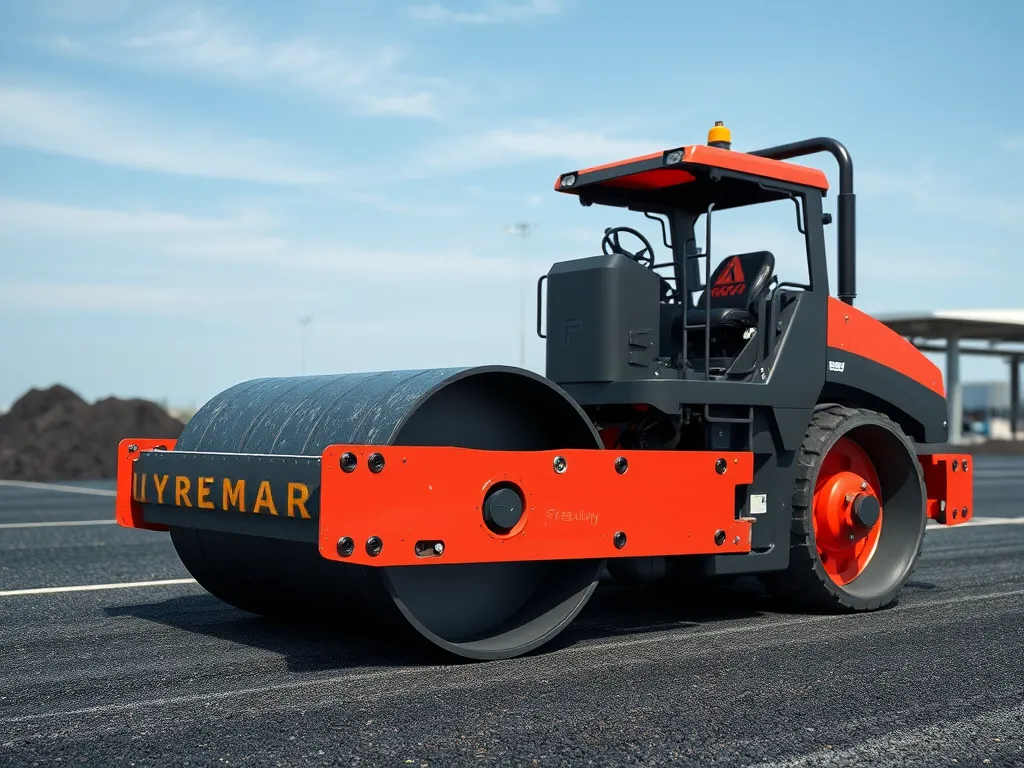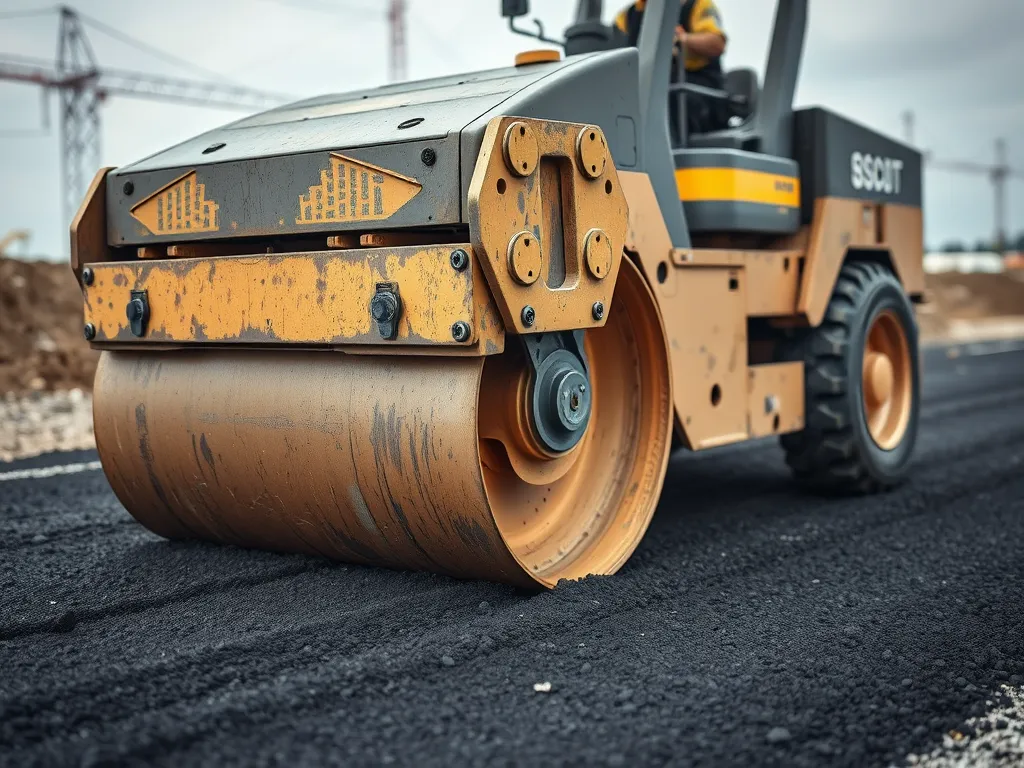Best Practices for Using Vibratory Rollers in Asphalt Compaction
Published on: September 7, 2025 | Last Updated: April 14, 2025
Written By: George Voss
Best practices for using vibratory rollers in asphalt compaction require precise machine settings and skilled operation to achieve optimal pavement density. These heavy machines use vibrating steel drums (1500-3000 vibrations per minute) to compress hot mix asphalt, removing air pockets and creating surfaces that last 15-20 years under heavy traffic. Operators focus on four core areas: speed control (2-4 mph), vibration adjustments, pass patterns, and daily maintenance. Proper technique prevents issues like thermal cracking while meeting density targets of 92-96% per ASTM D6925 standards.
This article breaks down vibratory roller operation into actionable steps. Learn how amplitude settings affect surface smoothness, why asphalt temperature dictates frequency choices, and how overlapping passes by 4-6 inches prevents uneven compaction. We’ll cover drum maintenance for preventing material sticking, OSHA-approved PPE requirements, and strategies to reduce fuel use by up to 20%. Whether compacting SMA mixes or thin overlays, these methods ensure quality results.
Contents
- Importance Of Vibratory Rollers in Asphalt Compaction
- How Vibratory Rollers Work for Asphalt
- Operational Best Practices for Asphalt Compaction
- Asphalt-specific Adjustments and Considerations
- Maintenance Guidelines for Vibratory Rollers
- Safety Protocols for Operating Vibratory Rollers
- Environmental Considerations
- Frequently Asked Questions (FAQs)
- Final Thoughts
- Additional Resources for You:
Importance Of Vibratory Rollers in Asphalt Compaction
Vibratory rollers form the backbone of asphalt compaction, transforming loose mixes into stable pavement. Their precise force application ensures material bonds form correctly, directly affecting road quality and lifespan. From highways to parking lots, these machines bridge the gap between mix design and real-world performance.
Role in Achieving Ideal Asphalt Density
Vibratory rollers deliver 92-98% density in asphalt layers through controlled vibrations. The combination of static weight and dynamic force pushes aggregates into tight alignment. Key factors driving success:
- Air void reduction to 3-8% (meeting Superpave standards)
- Uniform load distribution across all pavement layers
- Prevention of segregation in stone matrix mixes
Operators using vibratory roller best practices achieve 1.5-2.5% higher density than static rollers. This difference prevents premature rutting under 40-ton truck traffic.
Impact on Long-term Pavement Durability
Properly compacted asphalt with vibratory rollers resists water infiltration 70% better than under-compacted surfaces. Field studies show:
- 15-year lifespan extension versus hand-operated compactors
- 30% reduction in crack formation over 5 years
- 4x improvement in freeze-thaw resistance
Pavements compacted at 285°F (140°C) with dual-drum vibratory rollers maintain smoothness for 8+ years. This temperature sweet spot allows binder flexibility without causing drum sticking.
Mastering these fundamentals prepares crews for the next challenge: dialing in machine settings for specific job requirements. Let’s break down the mechanics behind vibratory compaction.
How Vibratory Rollers Work for Asphalt
Vibratory rollers transform loose asphalt mixes into solid road surfaces through force and motion. These machines combine static weight with rapid vibrations to push aggregate particles into tight arrangements. Proper use requires knowing what happens beneath the drum during compaction.
Working Principle Of Vibratory Compaction
A vibratory roller’s drum houses an eccentric shaft that spins during operation. This rotation creates centrifugal force, generating vibrations up to 3,000 pulses per minute. As the drum moves, vibrations temporarily reduce friction between asphalt particles. Aggregates slide into denser configurations, squeezing out air pockets and improving load-bearing capacity.
Effective compaction demands matching machine energy to mix characteristics. Hot asphalt layers compact easier due to pliable binder, while cooler surfaces require higher impact forces. Operators must start rolling when mix temperatures stay between 275°F and 175°F for optimal particle movement.
Vibration Mechanics: Amplitude and Frequency
Two settings control compaction efficiency: amplitude (vertical drum movement) and frequency (vibrations per minute). High amplitude (1.5–2 mm) works best for thick base layers, driving force deeper into the mat. Thin surface courses perform better with low amplitude (0.3–0.8 mm) to prevent aggregate fracturing.
Frequency adjustments range from 1,500 to 3,000 VPM. Faster vibrations (2,500+ VPM) suit granular materials but risk over-compacting asphalt. Slower frequencies (1,800–2,200 VPM) allow gradual settlement without displacing hot mix. Most asphalt projects use dual-frequency rollers, letting operators switch between 40 Hz and 50 Hz modes as layers cool.
Mastering these mechanics prepares crews for the next challenge: applying field-tested techniques during rolling operations.

Operational Best Practices for Asphalt Compaction
Mastering vibratory roller techniques ensures pavement longevity and smooth surfaces. Follow these field-tested methods to optimize density, avoid defects, and maximize equipment efficiency.
1. Adjusting Speed for Consistent Results
Roller speed directly impacts compaction quality. Too fast creates uneven density; too slow risks surface cracks. Maintain steady forward motion to let vibrations penetrate the mix.
Ideal Speed Ranges for Asphalt Layers
For thin layers (1.5-2 inches), operate at 2-3 mph. Thicker layers (3+ inches) allow 3-5 mph. On slopes, reduce speed by 30% to prevent material displacement. Always match drum width to paver output – a 60-inch drum covers 40-50 tons/hour when paired with a 10-foot paver.
2. Determining Optimal Number Of Passes
Most mixes achieve 92-96% density within 2-3 passes. Track progress with a nuclear density gauge after each pass. Stop when density gains drop below 1% per additional pass.
Avoiding Over-Compaction in Thin Layers
Thin asphalt courses (under 2 inches) require careful pass planning. Limit to 1-2 passes with vibration OFF after initial compaction. Overworking these layers fractures aggregates, reducing stability by up to 15%.
3. Managing Vibration Settings
Vibration controls separate vibratory rollers from static compactors. Adjust amplitude (vertical drum movement) and frequency (vibrations/minute) based on layer requirements.
Amplitude Adjustments for Surface Finish
High amplitude (0.8-1.2 mm) works best for base layers needing deep compaction. Switch to low amplitude (0.4-0.6 mm) on surface courses to prevent aggregate crushing and ensure 1/8-inch smoothness tolerances.
Frequency Selection Based on Material Temperature
Set frequency between 2500-3000 VPM (vibrations per minute) when compacting hot mix asphalt above 275°F. Reduce to 1500-2000 VPM as temperatures drop below 200°F to avoid rapid cooling and poor particle alignment.
4. Direction and Overlap Techniques
Overlap patterns prevent un-compacted stripes. Always roll perpendicular to the paver’s direction first, then parallel for final finishing.
Maintaining Uniform Overlap Between Passes
Overlap drum edges by 6-12 inches per pass. For dual-drum rollers, stagger overlaps between front and rear drums. On 12-foot lanes, make three passes: centerline, left edge, right edge – each overlapping the previous by 25%.
With these vibratory roller best practices dialed in, operators can tackle the next critical factor: temperature management during asphalt placement.
Also See: Asphalt Vs Concrete Vs Gravel: Which is Best?
Asphalt-specific Adjustments and Considerations
Effective vibratory roller use requires fine-tuning methods to match asphalt’s unique properties. Material behavior shifts with temperature, thickness, and mix design – demanding precise roller adjustments.
Temperature Management During Compaction
Mat temperature dictates compaction success. Roll within the 275-325°F window for optimal particle rearrangement. Below 230°F, bitumen stiffens rapidly – incomplete bonding occurs. High-frequency settings (3,000-3,500 vpm) work best with hot mixes, while lower frequencies suit cooling surfaces.
Monitor thermal segregation zones. Cold spots below 200°F need immediate roller focus or risk permanent density gaps. Infrared thermometers verify mat temps every 50 feet.
Adapting to Layer Thickness and Mix Type
Thicker lifts (4+ inches) benefit from high-amplitude settings (0.040-0.060 inches) to drive force deeper. Thin overlays (1.5 inches) require reduced amplitude (0.020-0.030 inches) to prevent aggregate fracturing.
Mix designs demand specific approaches:
| Mix Type | Roller Setting | Pass Strategy |
|---|---|---|
| Stone Matrix (SMA) | Low frequency, static finish | 2 vibratory + 1 static |
| Open-Graded (OGFC) | No vibration | Static only |
| Dense-Graded | Dual vibration | 4-6 passes |
Superpave mixes with PG 76-22 binder compact faster than PG 64-28 blends – adjust roller patterns to match viscosity changes.
Proper equipment care ensures these adjustments translate to field results. Next, we’ll examine maintenance routines that keep vibratory rollers performing at peak levels.

Maintenance Guidelines for Vibratory Rollers
Proper care extends equipment life while ensuring consistent compaction quality. Follow these protocols to keep rollers performing at peak levels.
Pre-operation Inspections
Check fluid levels (hydraulic oil, coolant) before starting the engine. Inspect drum surfaces for cracks or debris. Test vibration function at low speed to detect irregular noises. Tighten loose bolts to manufacturer torque specs—under-tightened fasteners cause 37% of early bearing failures. Verify sprinkler systems work to prevent asphalt sticking during compaction.
Cleaning and Lubrication Best Practices
Remove asphalt buildup daily using diesel or specialized solvents. Lubricate vibratory mechanism bearings every 8 operating hours with NLGI #2 grease. Apply high-temperature lubricant to drum pivots after cooling to 150°F. Neglecting greasing cycles increases friction by up to 60%, risking component seizure. Store rollers on level ground with drums elevated to avoid flat spots.
Drum Surface Maintenance for Asphalt Adhesion
Clean drums within 30 minutes of shutdown using non-abrasive tools. Inspect for scoring deeper than 1/8″—deep grooves reduce contact pressure, lowering density by 2-3%. Apply silicone-based release agents sparingly to minimize material pickup. For steel drums, maintain temperatures between 275-325°F during operation to optimize particle bonding. Never spray water on hot drums; thermal shock warps surfaces.
Proper maintenance keeps projects running smoothly but requires strict safety measures. Next, we’ll review protocols to protect crews while operating vibratory rollers.
Safety Protocols for Operating Vibratory Rollers
Proper safety measures form the backbone of effective vibratory roller operation. Let’s break down critical steps to keep crews safe while achieving asphalt density targets.
Worksite Hazard Identification
Scan the job site for risks before starting the engine. Uneven terrain, hidden debris, and overhead power lines account for 42% of roller-related incidents. Use ground-penetrating radar to locate underground utilities in urban zones. Mark soft shoulders or drop-offs with safety cones—slopes steeper than 1:3 require slope meters for stability checks. Train spotters to maintain 10-foot clearance zones around moving equipment.
Personal Protective Equipment (PPE) Requirements
Operators must gear up with ANSI-certified PPE:
- Steel-toe boots with slip-resistant soles (ASTM F2413-18 standard)
- High-visibility Class 3 clothing for low-light conditions
- Hearing protection rated for 85+ decibels during prolonged vibration
- Anti-vibration gloves to reduce hand-arm fatigue
Roller cabs with ROPS (Roll-Over Protective Structures) cut accident severity by 70% when paired with seat belts.
Mastering these protocols sets the stage for eco-conscious operation. Next, we’ll explore how fuel efficiency and noise reduction align with modern environmental standards.

Environmental Considerations
Modern vibratory roller operation demands balancing efficiency with ecological responsibility. Contractors must address fuel use, emissions, and noise pollution while maintaining compaction quality.
Reducing Fuel Consumption and Emissions
Diesel-powered vibratory rollers consume 2-4 gallons of fuel per hour. Tier 4 Final engines cut nitrogen oxide (NOx) emissions by 90% compared to older models. Operators lower fuel use by 15-20% through eco-mode settings and avoiding prolonged idling. Proper drum alignment and optimal pass counts (typically 3-5 per layer) prevent rework, saving up to 30 gallons weekly on large projects. Regular air filter checks and engine tune-ups further reduce particulate matter (PM) emissions below 0.02 g/kWh thresholds.
Noise Control Measures in Urban Areas
Vibratory rollers generate 85-95 decibels (dB) during operation – near OSHA’s 90 dB exposure limit. Urban sites require noise-dampened models with acoustic engine enclosures (75-82 dB) or electric-powered alternatives (68-74 dB). Schedule compaction during daytime hours (7 AM – 6 PM) to comply with municipal ordinances. Rubber-coated drums and vibration frequency adjustments below 2,500 VPM (vibrations per minute) decrease low-frequency noise propagation. In residential zones, use non-vibratory static modes for final passes to meet 55-65 dB nighttime limits.
These environmental strategies work best when paired with rigorous equipment maintenance – a critical factor we’ll explore next.
Frequently Asked Questions (FAQs)
Are Vibratory Rollers Efficient in Compacting Asphalt?
Yes, vibratory rollers are highly efficient in compacting asphalt due to their ability to deliver controlled vibrations that effectively eliminate air pockets and enhance density. They can achieve up to 92-98% density, which significantly improves the performance and longevity of paved surfaces.
What is the Working Principle Of a Vibratory Roller?
Vibratory rollers operate using an eccentric shaft within the drum, which produces vibrations as it rotates. These vibrations reduce friction among asphalt particles, allowing them to settle tightly together, thus increasing the density of the asphalt mix efficiently.
How Much Productivity Does a Vibratory Roller Produce Per Hour?
The productivity of a vibratory roller can vary based on the project specifics, such as layer thickness and job site conditions, but typically, a vibratory roller can compact a minimum of 20,000 square feet of asphalt per hour under optimal conditions.
What Maintenance Practices Should Be Implemented for Vibratory Rollers?
Regular maintenance practices for vibratory rollers include pre-operation inspections for fluid levels and drum surface condition, daily cleaning to remove asphalt buildup, lubricating moving parts as specified by the manufacturer, and monitoring drum surface integrity to ensure optimal compaction performance.
How Can Operators Ensure Safety While Using Vibratory Rollers?
Operators can ensure safety by identifying worksite hazards, wearing appropriate personal protective equipment (PPE), such as high-visibility clothing and hearing protection, and maintaining clear communication with ground personnel. Additionally, it is vital to observe all safety regulations set forth by industry standards.
What Environmental Measures Can Be Taken While Operating Vibratory Rollers?
To mitigate environmental impact, operators should utilize eco-friendly engine settings to reduce fuel consumption, select noise-reducing models when working in residential areas, and adhere to regulations by scheduling work during approved hours to minimize disruption.
How Do Temperature and Mix Type Affect the Use Of Vibratory Rollers?
The temperature of the asphalt mix directly affects compaction quality; rolling should occur within the recommended temperature range to achieve optimal particle arrangement. Different mix types also require adjustments in roller settings, such as amplitude and frequency, to accommodate their specific characteristics.
Final Thoughts
Implementing best practices for using vibratory rollers enhances asphalt compaction efficiency and pavement longevity. Prioritize proper speed adjustments and vibration settings to achieve consistent results. Remember to monitor temperature and layer thickness for optimal performance.
Regular maintenance of vibratory rollers ensures effective operation and safety. Conduct pre-operation inspections, maintain drum surfaces, and keep equipment clean and lubricated. These practices not only extend equipment life but also improve asphalt adhesion.
Adhering to safety protocols protects workers and mitigates hazards on site. Equip operators with the necessary personal protective equipment and promote awareness of workplace risks.
For more guidance and in-depth information, visit Asphalt Calculator USA. Maximize your asphalt compaction efforts with the right techniques and insights!
Additional Resources for You:
- American Association of State Highway and Transportation Officials (AASHTO). (2008). Mechanistic-Empirical Pavement Design Guide (MEPDG). Washington, DC: AASHTO.
- How Vibratory Rollers Work – A Detailed Guide from Sniper Rentals
- What are the advantages and disadvantages of using vibratory rollers for soil compaction?


